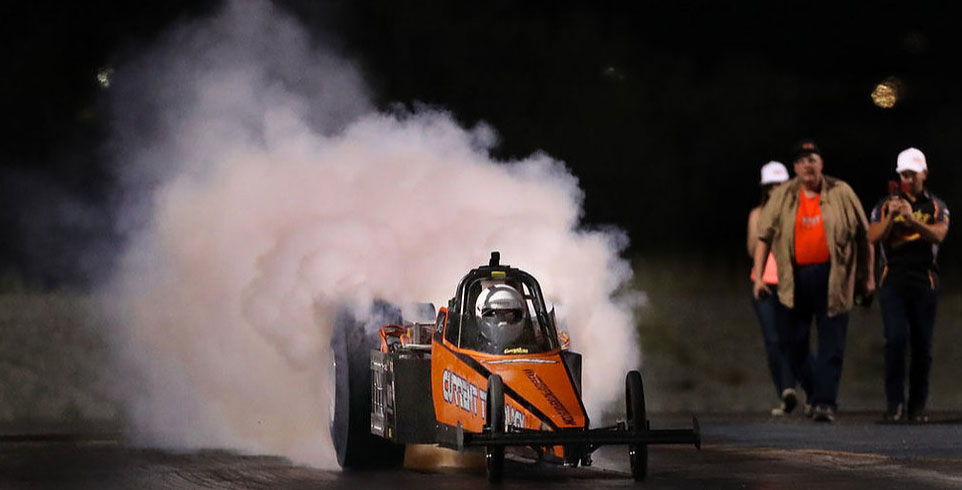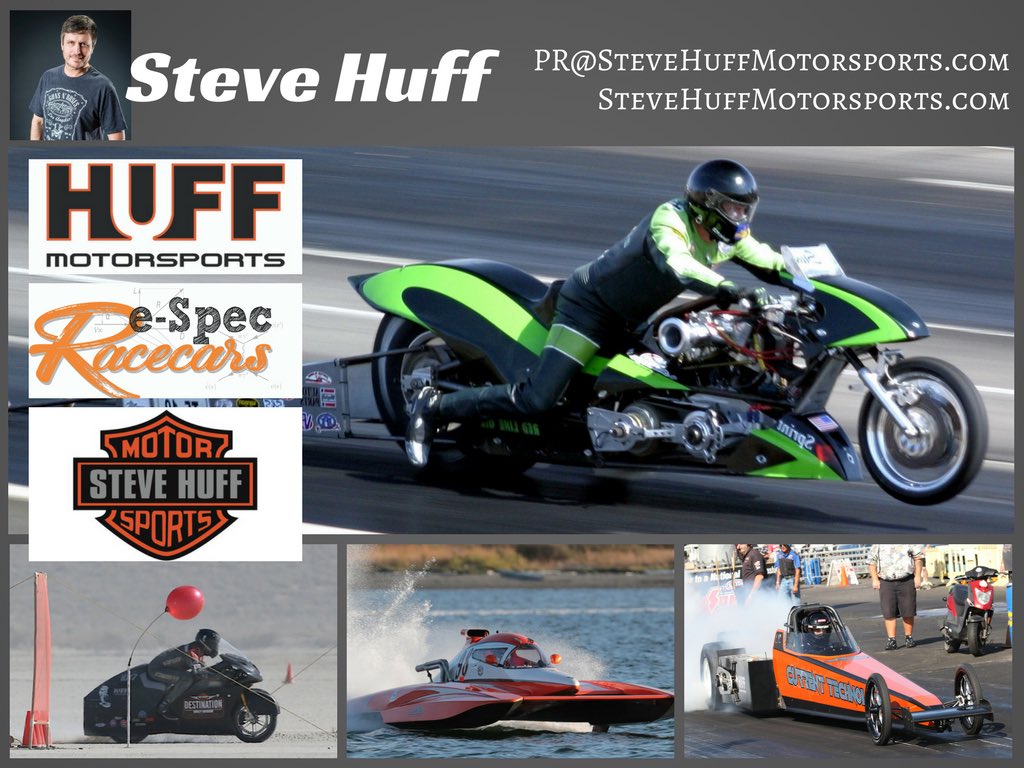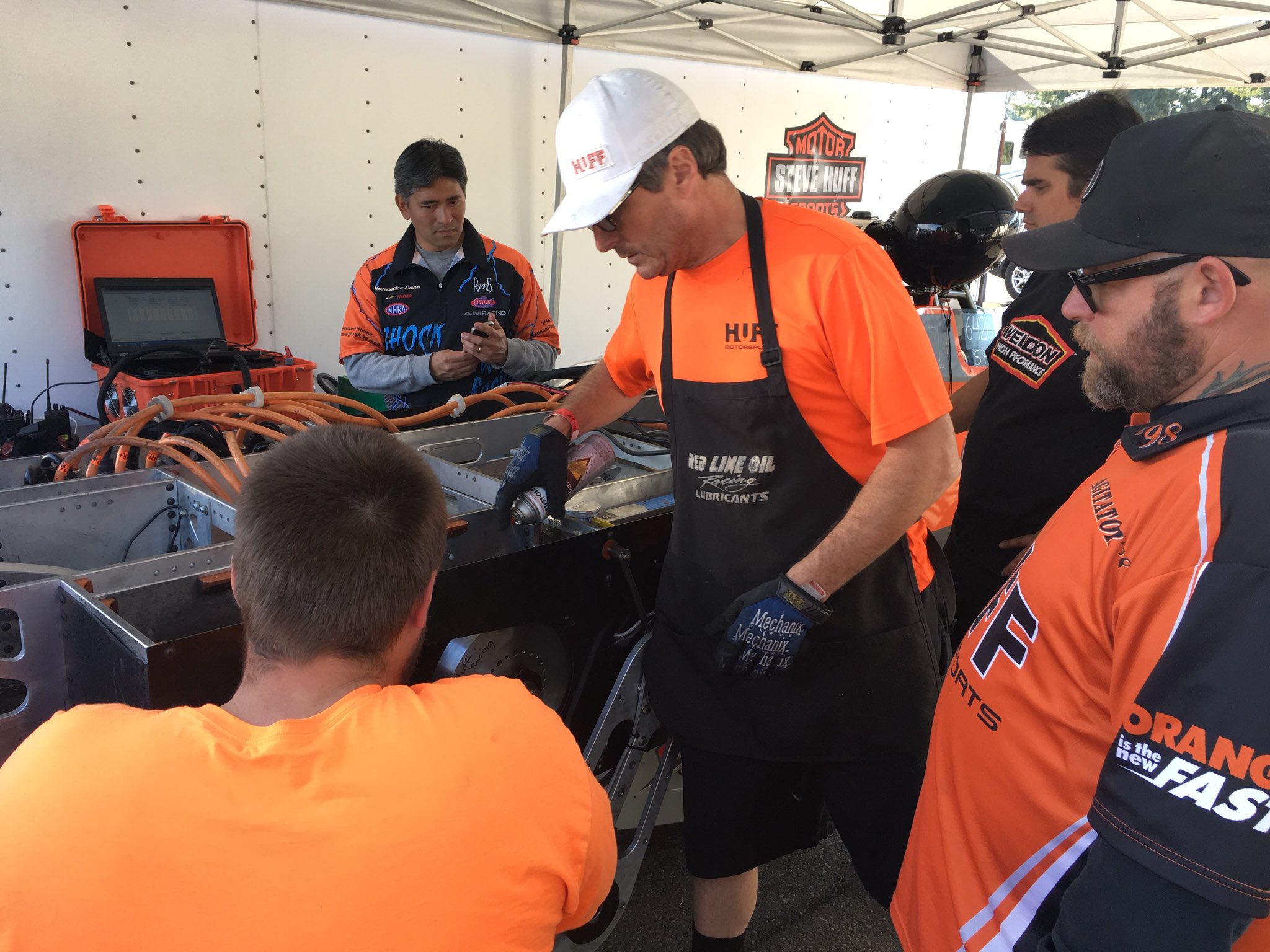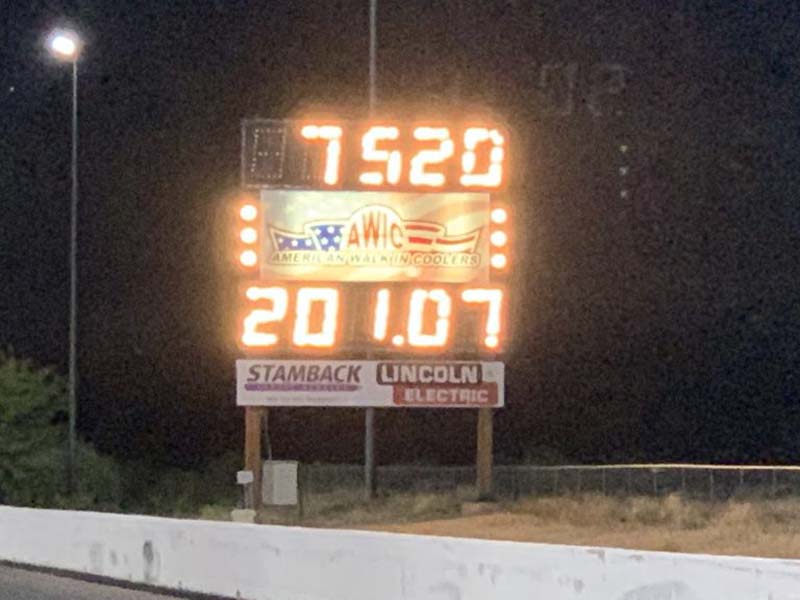STEVE HUFF: DRAG RACING'S 200 MPH ELECTRIC MAN, INNOVATES AND BATTLES LIFE'S CHALLENGES

It doesn’t take but a few minutes of conversing with Steve Huff to realize he’s not like you -- and probably not like anyone else you’ve ever met.
And that’s not even taking into account that Huff, 54, has three kidneys, is battling rare cancer, or that he is an accomplished innovator despite the fact that he and his mother were homeless for a time.
 He’s a record-setting drag racing motorcyclist. He pilots hydroplanes. He helped figure out how to harness electricity for racing purposes, then became the first man to break the 200-mph barrier in an electric dragster. He’s broken bones in pursuit of speed. He owns a flat-track motorcycle racing team. He’s got what he calls a “legit” reality show that’s almost ready for TV. He describes the underpinning of his business success -- Steve Huff Motorsports -- as “solving problems.”
He’s a record-setting drag racing motorcyclist. He pilots hydroplanes. He helped figure out how to harness electricity for racing purposes, then became the first man to break the 200-mph barrier in an electric dragster. He’s broken bones in pursuit of speed. He owns a flat-track motorcycle racing team. He’s got what he calls a “legit” reality show that’s almost ready for TV. He describes the underpinning of his business success -- Steve Huff Motorsports -- as “solving problems.”
And all of the aforementioned accomplishments were made without the benefit of a formal education past high school.
When he informed his business attorney in 1997 that he was selling his construction company to chase speed full-time, the attorney asked, “Why? Your business is very successful.”
Here’s the answer Huff supplied half a life ago: ‘I don’t want to wake up one morning at 50 and wish I had done something else.’
“Ever since then, I’ve had a smile on my face I haven’t gotten rid of. I never looked back,” Huff said. “Now, in times like this when a doctor says that you’ve got a terminal case, I think … ‘Thank God I didn’t go to work someplace as a number and save my money to go do something after I retired. Thank God I went for it. I just went for it.’ ”
Steve Huff doesn’t approach things with trepidation or half-heartedly. His approach is more along these lines: If you’re going to get in the pool, you might as well start in the deep end.

A prime example of that tracks back to his introduction to drag racing when, in 1997, he started his career with a nitromethane-fueled Harley-Davidson Sportster brandishing a carbureted Ironhead engine. He quickly realized that Ironhead wasn’t going to put him in the winners circle, so he changed gears and developed a “relatively short-stroke engine” whose trek to fruition took a year and a half.
When it was finished, he hauled his bike from his home base in Seattle to Daytona Beach, Fla. -- a true cross-continent odyssey of nearly 3,100 miles -- for its first competitive test in the class then known as Pro Dragster.
Let’s just say things didn’t go as planned.
“I was the first nitro bike for qualifying on Saturday. Took a big whack of the throttle, launched out about 10 feet and it died,” he said.
“And 3/10ths of a second later, all four spark plugs (fired). The feature we needed to be removed from the ignition system hadn’t been removed, and it lit that nitromethane and grenaded me off that motorcycle like I’d never been moved before. I was in the back of the ambulance for quite a while. When they released me from the ambulance … I was down in the dumps in the pits and this mess of an engine wedged in the frame.”
As he took stock of the mass of junk he’d made from 18 months’ work, two men approached him. One was motorcycle drag racing legend Jim McClure. The other was Jody Anderson, who, at the time, was the head of the racing department for S&S Cycle. Anderson said to McClure, “This is the guy I’ve been telling you about.”
McClure said to Huff, “I’ve been watching what you’re doing, and I think you’re on the right track.”
Suddenly, Huff forgot about his catastrophic mechanical failure. Anderson remarked that the engine combination on which Huff had been toiling was unique, adding, “I believe if you can keep doing this, you’re going to do something on this short-stroke engine.” He backed up his belief in the young innovator by providing S&S sponsorship that same day.
Back to the drawing board Huff went, and his bike was the first carbureted Harley to break 180 at the dragstrip. He eventually upped that to “182 and change,” and in 2001, he set an eighth-mile class record at 154 mph.
In time, Huff purchased one of McClure’s bikes to make the jump to Top Fuel. It was the only time, Huff said, that McClure ever sold one of his bikes.
“Jim’s stuff was always a little different and so was mine,” Huff said. “I asked him later why he sold me his bike. He said, ‘Because I don’t want to be embarrassed. You’re the first guy I’ve met that I think can make this bike go faster than I can’ -- but I never did.”

Motorcycle drag racing eventually ran its course for Huff, who had also dabbled in road racing before making the move to two-wheelers on nitro.
“If you’ve got an ego, go drag racing,” he said. “In road racing, if you screw up in one corner, you’re like, ‘I’ve got five laps to make that up.’ In drag racing, you screw up, that’s it.”
Huff then added hydroplane racing to his resume, and he also had an NHRA Competition Eliminator entry equipped with a Harley-Davidson engine.
In late 2015, as Huff recalls, he was watching TV as he prepared a stack of Christmas cards to be mailed. He happened to see an interview with drag racing legend “Big Daddy” Don Garlits, who was discussing electric-powered cars.
“‘What the hell is Don Garlits doing with electric cars?’" Huff said he thought. “He said, at that time, that Swamp Rat 37 was an electric dragster and they’d been into it about four years at that time - the Quest for 200, or something like that, trying to be the first 200-mile-an-hour car in the quarter-mile.”
Larry McBride already had eclipsed 200 in the quarter on an electric-powered motorcycle in 2012 at Virginia Motorsports Park. Garlits hoped to do the same with the heavier Top Fuel-style dragster.
“During the interview, Don said, ‘Electric vehicles are going to be a part of everyone’s future, and to go 200 in the quarter is just not possible with the current technology,’ ” Huff said. “I thought, ‘That’s a bunch of crap. They’re just doing it wrong.’ ”
And with that, Huff embarked on a sprint to beat Garlits to 200 with a dragster he built that is called -- both for its electrical motivation and as a mildly snarky rebuke of “Big Daddy’s” opinion at the time -- “Current Technology.”
“I put my mouth out there in front of me like usual and let my ass follow, but that’s what inspired me,” Huff said.
Then he set out to get to 200 in a way others hadn’t.
Rather than attacking the problem by looking for a DC solution -- Direct Current being a one-way flow of electricity -- like everyone else had tried, Huff did the opposite. He began developing power using Alternating Current, which Wikipedia defines as an electrical current that ‘periodically reverses direction and changes its magnitude continuously with time.’ That meant employing a clutch and a flywheel as a way to control the output.
His outlook, he explained, was duels between different schools of thought to achieve a similar result: DC vs. AC, Edison vs. Tesla, Garlits vs. Huff.

So how is it that Huff’s way worked so well that he carved out a place in drag racing history? He makes it sound simple.
“When an electric DC motor isn’t spinning, all sorts of bad things happen when you put power to it,” Huff said. “With a clutch, you can tune it, get a good launch, can have a motor spinning at one-sixth speed -- essentially, like a Top Fuel car or bike -- and nobody had done it. What a perfect opportunity it was for me to put my money where my mouth is.
“I used the same belt-drive, same primary drive, same belt, and the same clutch I worked with and developed with Jim McClure 20 years ago. And I kept modifying the size of the clutch.”
When he thought he had all the pieces assembled correctly, Huff and crew made a three-hour drive from Seattle down to Woodburn (Ore.) Dragstrip. He added to a modified General Motors motor a controller, which Huff said in his application acts like a fuel injection computer to manage how much electricity to dole out and when.
The early runs were at 180 and elapsed times in the 7.90s and 8-ohs. With the clutch included in the equation, the dragster’s 60-foot times were shaved from 1.5 seconds to 1.15. Huff also returned home to machine a 50-pound flywheel whose mass would improve the dragster’s launch.
“The first day at the track, I didn’t have the flywheel on it. It’s a 10,000-rpm motor, and when I tried to launch on the button at 7,500, it’d pull the motor down to 1,000 rpm,” he said. “I knew right away we needed flywheel mass, so I went back to Seattle. All the people who were following us wanted to know why I left, what’s going on. I told (publicist Jill Andrews) to tell them I went home to build an ‘energy storage device,’ and all the electric guys were guessing ‘bet he’s bringing back capacitors’ and this and that.
“Then I showed up with a 50-pound piece of steel, bolted it on the car and off we went. Some things are really simple. You can make things as complicated as you want to make them, but in the wise words of Jim McClure, ‘If you don’t tell it, it won’t know it. I treated it as a rotating assembly.”
Then Huff ditched the GM motor for a ‘pancake’-style motor without significant improvement. He was still a solid 6-7 miles per hour behind Garlits’ best of 189.
“I didn’t think I was going to get there,” he said.
That’s when he approached Colorado’s Derek Barger about creating a much more powerful battery. Barger became part of the team with Huff and Larry Carrell, whom Huff calls “kind of my principal backer.” Barger built a battery capable of producing 2,000 amps; amperes measure the strength of electrical current. (By comparison, the magnetos providing fire to Top Fuel dragsters and nitro Funny Cars deliver 44.)

Down the road, the Carrell-Huff-Barger dragster was outfitted with four motors and four controllers, “but we didn’t have a way to control all that stuff,” Huff said. To solve that issue, he incorporated an AEM-built processor that acts like a throttle input by sending power equally to the four motors.
“At the PRI and SEMA shows in 2017 that was a novel item,” Huff said, “but it was sort of put on the back burner until the industry caught up. When that happened, AEM had a computer for us. Instead of saying ‘This is the future,’ they said, ‘No, it’s now. It’s real, you can touch it.’ … I don’t know that that’s completely uncommon. I think we’re about five years ahead of the curve, and we continue to advance.”
By this point, it’s May 2020 and Huff is ready to give it another shot -- only COVID-19 had closed down most racing facilities and racing-related manufacturers. Huff called Jim Hughes, the owner of Tucson (Ariz.) Dragway, and asked if he could bring the dragster to make some runs. “C’mon over,” Hughes said.
The team started its runs down the track at dark, when cooler temperatures would allow for improved performance. The numbers on his shortened runs didn’t produce the numbers Huff wanted, but he said, “(Expletive) it, I’m gonna go for it, let’s run it through the lights” -- and while he spun the tires as he approached the finish line, computer data told him the dragster had reached 193 mph at the 1,200-foot mark. Another run upped that number to 197 at 1,000 feet.
That’s when Huff really got -- pardon the pun -- amped up. Just before midnight on May 14, on his last pass of the night, the car didn’t just reach 200. It blew past it at 201.07 mph.
“Then the next day we came out and did it again, and again the next time,” he said. “That was everything we had” and didn’t include a clutch in the set-up.
“This year we’ll be putting a clutch in it,” said Huff, who later went 201.37 at his hometown track, Pacific Raceways, near Seattle.
That was around the time the back pain Huff had been experiencing for about three years spiked -- and did so in a way that scared him. He initially thought it was a hip issue that might require replacement surgery.
Tests initially showed him to have three kidneys, not two, and one of them had ruptured and become blocked. Doctors told him he would be OK, and tests of his bladder and kidneys didn’t show cancer … on the inside. The cancer, it was later discovered, was on the outside of one of the kidneys.
“I had a lot of doctors and a lot of negative test results,” he said. “The doctors at the University of Washington said last year, ‘Listen, if you get this symptom again, come here.’
Surgery to remove the third kidney was scheduled, but about a week prior, he “heard a snap” in his back.
“I called one of my guys and said, ‘Get me to the hospital now!’ And when we got there, I told them the kidney was coming out in a week. They said, ‘Steve, you broke (vertebra) L-3 because there’s a lesion on your spine’ -- and I knew what that meant.”
Cancer.
Specifically, Huff was diagnosed with Advanced Urothelial Carcinoma, a disease that affects cells in the urinary tract and is most commonly found in patients ages 70 and up.
Huff completed radiation treatments in December and those have reduced his pain. He’s had his spine tested and been determined fit to race. He’s also finished his first round of chemotherapy and has another four-month course to go.
But his long-term prognosis isn’t as upbeat as one might hope.
“It’s a rare form of kidney cancer that we’d been looking for a while, and it seems like we might’ve caught it a little too late,” Huff said. “It’s spread out quite a bit.
“This chemo will knock you down a bit, but I’ve done tougher,” he added. “Statistically it’s not promising, but those statistics are on people who are 70 years old. I’m not that. I’m in great shape, and racers are fighters. Survival stories are everywhere in my life, but I look around and realize it’s because we’re all like-minded people. The common denominator is that these people are fighters and they’re tough.
“Some of the world’s leading cancer research is up here,” he said, citing the Fred Hutchinson Clinic, the University of Washington and the Seattle Cancer Care Alliance. “It’s just a really amazing team. My life -- the longevity of my life -- is counting on it.”

Simply, Huff doesn’t have time to waste, never did. He continues to ponder, devise and implement changes to the electric dragster to see if it can reach its potential. He has countless people to educate on how to make advances with battery-powered vehicles of all types. He has a TV show he’s been developing for almost nine years -- “Speed Geeks: The Science of Speed” -- in the works that will be taken to market by Chassy Media, which is headed up by Adam Carolla and Nate Adams. He is excited about possible side-by-side duels with Garlits in their electric dragsters.
Huff hopes others are inspired by his drag racing efforts and already sees signs that he’s on the right track there.
“When we have the car at an event, people under 30 walk up and ask how many kilowatts it makes. Old knuckle draggers like me ask about horsepower,” he said. “The LS (engine) swap of today will be a Tesla swap for hot rodders of the future. It’s neat stuff and a helluva lotta fun. I’m more of a fan of challenges than anything else.”
He remembers what it was like to be an impressionable teenager who was driven to learn. He said he had “great teachers” in high school, then attended a technical school that was a “waste of my time because it was too easy.” He’s mostly self-taught through reading, hands-on education, and he’s made the most of the opportunity to pick the brains of drag racing standouts Jim McClure and Art Whipple, motorcycle racer Alan Sputhe, and hydroplane mentors Ron Jones Jr. and Wally Johnston.
“I loved this mechanical stuff, taking things apart and making them work. To hang out with Garlits, McClure, Sputhe -- teachers and mentors of mine -- I’ve been trained by the best.”
Those men, he said, inadvertently showed him the key to innovation and solving problems.
“They taught me how to think,” he said. “Students today are told WHERE to find the answer, not HOW to find the answer. That’s something that really, really gets me. That’s why education is so important.”
That belief helped spawn “Speed Geeks,” and he believes the show will strike a chord with viewers because it is designed to make them think. The show, Huff said, is about the math, science and physics behind the world’s fastest things, and touts the fact that rules really are made to be broken.
“As soon as they put rules on to slow a class down, they go faster, whether it’s F1 or Top Fuel,” Huff said. “It’s about problem solving and solutions. Our company is a solutions-based company; we solve problems.”
What “Speed Geeks” is not, Huff said, is a “scripted reality” show. One example is an episode that breaks nitromethane down in depth. It will feature guests such as Garlits and Eddie Hill, the first drag racer to break the five-second barrier in the quarter-mile.
“If you do the same the last guy did,” Huff said, “you only go as fast as the last guy. We’re constantly developing, constantly looking for new things. … I’ve got some brilliant people on my staff” for the show. “I try to make sure I’m not the smartest guy in the room.
“You’re gonna stay tuned to find out if it’s really going to go faster,” he said of the show’s speed experiments. “It’s 100 percent the antithesis to ‘Jackass.’ Let’s contribute and let’s leave it better than we found it.’
Keeping his mind, which is blessed with an eidetic memory, and his hands busy are a way, Huff believes, to keep his cancer suppressed for as long as possible. At first, the disease took a toll on a man who’s used to walking 35,000 steps a day. Now he’s back to something close to his usual hectic pace.
“I’m not in any pain right now from the radiation treatment, my mind’s working properly, my body’s working properly,” he said. “The low dips of chemo are the worst I have to deal with, and I know there are a lot of people dealing with a lot, lot worse.
“I’ll eat right, exercise right and follow doctor's orders, and we’re going to learn to live with this. I’ve broken my neck, my right ankle has had seven surgeries -- the list is extensive -- and I’ve beaten the odds medically and on the track lots of times. I know that we can do that now.”
That’s why he doesn’t put a lot of stock in his doctors’ cancer prognosis. He figures he has always managed to beat the odds, so why not this time, too?
“I’m going to do everything I can to be a survivor,” he said. “They told me a couple months ago, ‘You’ve got a year. Make it count.’
“I said, ‘You’re going to see me a lot longer than a year.’ ”
For a limited amount of time, you can get any 4 https://t.co/Reh86n8GFm face coverings for just $40. Click here to get yours - https://t.co/wSrXmpHBQm pic.twitter.com/L0JVyB2Mnr
— Competition Plus (@competitionplus) December 30, 2020










































